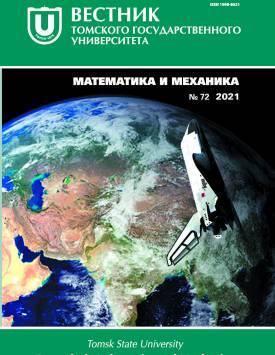Simulation of an unsteady incompressible fluid flow through a perforated pipeline
A mathematical model of the unsteady flow of an incompressible viscous fluid through a perforated pipeline is proposed, which is described by a system of nonlinear partial differential equations. In the framework of the model, the purpose is to determine the pressure and the flow rate of the fluid at the pipeline inlet, providing the flow rate and the pressure required at the pipeline outlet. By combining the system of the equations, the original problem is reduced to a boundary-value inverse problem for a nonlinear parabolic equation with respect to fluid flow rate. To solve the boundary inverse problem, the method of nonlocal perturbation of boundary conditions is proposed. A discrete analog of the inverse problem is obtained using the finite-difference approximation, and a special approach is suggested for solving the resulting system of difference equations. As a result, the difference problem for each discrete value of the time variable splits into two second-order difference problems and a linear equation with respect to an approximate value of the desired flow rate at the pipeline inlet. The absolutely stable Thomas method is used to numerically solve the obtained difference problems. After determining the flow rate distribution along the entire pipeline, the pressure at the pipeline inlet is also calculated using an explicit formula. Based on the proposed computational algorithm, the numerical experiments are performed for benchmark problems.
Keywords
perforated pipeline,
unsteady flow,
boundary inverse problem,
method of nonlocal perturbation of boundary conditions,
difference problemAuthors
| Gamzaev Khanlar M. | Azerbaijan State Oil and Industry University | xan.h@rambler.ru |
Всего: 1
References
Marshall E.A., Trowbridge E.A. Flow of a Newtonian fluid through a permeable tube: The application to the proximal renal tubule // Bulletin of Mathematical Biology. 1974. V. 36. P. 457-476.
Ross S.M. A mathematical model of mass transport in a long permeable tube with radial convection // Journal of Fluid Mechanics. V. 63. 1974. No. 4. P. 157-175.
Pozrikidis C. Stokes flow through a permeable tube // Archive of Applied Mechanics. 2010. V. 80. No. 4. P. 323-333. DOI: 10.1007/s00419-009-0319-9.
Zhang Q., Wang Z. Modeling study on fluid flow in horizontal perforated pipes with wall influx // International Journal of Fluid Mechanics Research. 2014. V. 41. No. 6. P. 556-566. DOI: 10.1615/InterJFluidMechRes.v41.i6.80.
Elshahed M. Blood flow in capillary under starling hypothesis // Applied Mathematics and Computation. 2004. V. 149. No. 2. P. 431-439.
Muthu P., Berhane T. Mathematical model of flow in renal tubules // International Journal of Applied Mathematics and Mechanics. 2010. V. 6. No. 20. P. 94-107.
Mariamma N.K., Majhi S.N. Flow of a Newtonian Fluid in a blood vessel with permeable wall - a theoretical model // Computers & Mathematics with Applications. 2000. V. 40. No. 12. P. 1419-1432.
Гамзаев Х.М. Обратная задача нестационарного течения несжимаемой жидкости в трубе с проницаемой стенкой // Вестник ЮУрГУ. Серия «Математика. Механика. Физика». 2020. T. 12. № 1. С. 24-30.
Мерзляков А.В., Крюкова Е.А. Свободные колебания идеальной жидкости в прямоугольном сосуде с горизонтальной проницаемой перегородкой // Вестник Томского государственного университета. Математика и механика. 2019. № 60. C. 107-118. DOI: 10.17223/19988621/60/8.
Thomas C. Flow in perforated pipes: A comparison of models and experiments // SPE Production & Operations. 2006. V. 21. No. 2. P. 302-311.
Zhang Q., Wang Z., Wang X., Zhai Y., Wei J., Gao Q. Analysis of the modeling of singlephase flow in a perforated pipe with wall fluid influx // Applied Mechanics and Materials. 2013. V. 275-277. P. 491-495.
Лурье М.В. Математическое моделирование процессов трубопроводного транспорта нефти, нефтепродуктов и газа. М.: РГУ нефти и газа им. И.М. Губкина, 2012. 456 с.
Alifanov O.M. Inverse heat transfer problems. Berlin: Springer, 2011.280 p.
Samarskii A. A., Vabishchevich P.N. Numerical Methods for Solving Inverse Problems of Mathematical Physics. Walter de Gruyter, 2007. 438 p.
Vabishchevich P.N., Vasil’ev V.I. Computational algorithms for solving the coefficient inverse problem for parabolic equations // Inverse Problems in Science and Engineering. 2016. V. 24. No. 1. P. 42-59. DOI: 14.1080/17415977.2014.993984.
Gamzaev Kh.M. Numerical method of pipeline hydraulics identification at turbulent flow of viscous liquids // Pipeline Science and Technology. 2019. V. 3. No. 2. P. 118-124. DOI: 10.28999/2514-541X-2019-3-2-118-124.

